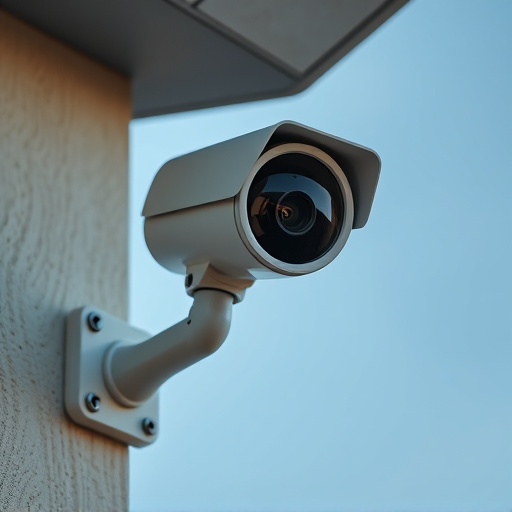Strategically mount dummy cameras at visible entry points, high-traffic areas, and locations with ample natural light for optimal security coverage. Consider field of view, blind spots, lighting, and obstructions. Use robust hardware, tools, and follow manufacturer instructions for secure installation while adhering to privacy regulations. Regularly inspect and adjust camera placement based on evolving needs and environmental factors.
“Enhance your home or business security with an exterior fake CCTV mounting system. This comprehensive guide provides step-by-step instructions on where and how to mount dummy cameras effectively. From evaluating your exterior for optimal placement, selecting the right camera locations, to gathering essential tools and materials, we cover it all. Learn the secrets to securely installing these decoys, testing coverage, and ensuring a discreet yet powerful security measure.”
- Evaluating Your Exterior for Mounting Options
- Choosing the Right Dummy Camera Placement
- Tools and Materials Required for Installation
- Step-by-Step Guide to Securely Mounting Cameras
- Testing and Positioning for Optimal Coverage
Evaluating Your Exterior for Mounting Options
Evaluating your exterior for mounting options is a crucial step in installing fake CCTV cameras effectively. The first consideration is location—choose an area that offers clear visibility and access to the desired surveillance zone. This could be on a wall, fence, or any structure surrounding your property. Ensure the chosen spot receives adequate natural light during the day for optimal camera performance, particularly if you’re using dummy cameras designed to mimic real ones.
Additionally, assess the security and weather conditions of the location. A sturdy mounting point is essential to prevent theft or damage, especially in areas visible from public spaces. Consider factors like wind exposure, rain, and UV radiation when selecting a spot, as these elements can impact the longevity of your camera setup. Where to mount dummy cameras strategically depends on your specific needs, ensuring comprehensive coverage while aligning with practical considerations for successful surveillance.
Choosing the Right Dummy Camera Placement
Choosing the right location for your dummy cameras is a crucial step in enhancing home or business security. When deciding where to mount fake CCTV cameras, consider high-traffic areas and visible locations. These can be entry points, such as front doors, garage entrances, or backyards, where potential intruders might approach. Strategically placing these decoys can deter crime by giving the appearance of a well-monitored property.
Think about the field of view each camera provides; you want to ensure they cover key areas without overlapping. This placement ensures that blind spots are minimized, providing a comprehensive security network. Additionally, consider factors like lighting and natural obstructions, ensuring cameras have optimal visibility during various times of day, including low-light conditions.
Tools and Materials Required for Installation
To successfully install exterior fake CCTV cameras, you’ll need a selection of tools and materials tailored for this task. Firstly, gather a set of basic hand tools including wire cutters, pliers, and screwdrivers (both flathead and Phillips). These will be essential for disassembling and installing components. Additionally, secure mounting hardware specific to your chosen camera model, such as brackets or screws designed for exterior use, capable of withstanding varying weather conditions.
When considering where to mount dummy cameras, opt for strategic locations visible from entry points and common areas. Common spots include garage doors, front entrances, back patios, and windows. Ensure the selected area offers adequate lighting to maximize the camera’s effectiveness while adhering to local privacy regulations regarding surveillance equipment placement.
Step-by-Step Guide to Securely Mounting Cameras
Mounting security cameras, whether real or dummy, requires careful consideration to ensure optimal visibility and protection against theft or damage. Start by choosing a suitable location – where to mount dummy cameras is just as crucial as with functional ones. Look for an area that offers clear line-of-sight, away from obstructions like trees or buildings, to capture the most comprehensive view. Ideally, it should be at eye level or slightly elevated to prevent blind spots.
Next, gather your tools: a drill with appropriate bits, screws suitable for the mounting bracket and surface, and possibly cable ties for extra security. Ensure the surface is clean and dry before proceeding. Follow the manufacturer’s instructions for installing the mounting bracket, securing it tightly with screws. Attach the camera to the bracket, then firmly fasten it in place using the provided hardware or additional locks if available. Regularly check the stability of the setup and consider reinforcement measures for areas prone to high winds or physical tampering.
Testing and Positioning for Optimal Coverage
When mounting fake CCTV cameras, testing and positioning are crucial steps for achieving optimal coverage. Start by identifying where to mount dummy cameras—strategic locations like corners, entry points, and high-traffic areas offer comprehensive views while maintaining a subtle presence. Ensure the cameras have clear lines of sight, avoiding obstructions such as trees, signs, or large furniture that could block their view.
During testing, verify that each camera captures clear, detailed images both during the day and night. Adjust the camera’s angle, zoom, and infrared settings to maximize visibility. Positioning should also consider lighting; well-lit areas help maintain image quality while reducing false alerts from movement in darkness. Regularly assess and adjust camera placement for evolving needs and environmental changes to maintain effective surveillance.
When mounting exterior dummy cameras, understanding your space is key. By evaluating your surroundings and choosing strategic placement, you can create an effective security network. The right camera positioning ensures optimal coverage, deterring potential intruders. With the right tools and a simple step-by-step process, you’ll have a secure system in no time. Remember, where you mount your dummy cameras is crucial for comprehensive protection, so take the time to plan and test for best results.
